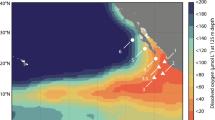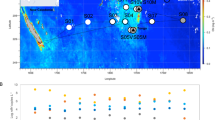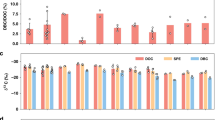Abstract
THE amount of dissolved organic carbon (DOC) in sea water is controversial1,2 Using a high-temperature catalytic oxidation (HTCO) technique, Sugimura and Suzuki3 reported that surface waters contained 2–4 times as much DOC as that measured previously using wet chemistry and ultraviolet oxidation techniques4,5. They also observed a relationship between DOC content and apparent oxygen utilization suggesting that the consumption of DOC is responsible for oxygen depletion in the deep sea. How to reconcile the apparent differences between these techniques has not been clear. Here we provide independent confirmation of the findings of Sugimura and Suzuki. We collected surface and deep waters from the equatorial Pacific Ocean, the Drake passage and the Atlantic Ocean south of Iceland, and analysed their DOC content using the HTCO methodology3. We found DOC concentrations 2–3 times higher than those measured previously. These results imply that the carbon content of the oceans has previously been underestimated by 1012 (1,000 billion) tonnes, and that the new estimated total of 1,800 billion tonnes represents one of the largest carbon reservoirs on Earth6. We found no evidence of a cause-and-effect relationship between DOC and apparent oxygen utilization.
This is a preview of subscription content, access via your institution
Access options
Subscribe to this journal
Receive 51 print issues and online access
$199.00 per year
only $3.90 per issue
Buy this article
- Purchase on Springer Link
- Instant access to full article PDF
Prices may be subject to local taxes which are calculated during checkout
Similar content being viewed by others
References
Toggweiler, J. R. Nature 334, 468 (1988).
Williams, P. M. & Druffel, E. R. M. Oceanography 1, 14–17 (1988).
Sugimura, Y. & Suzuki, Y. Mar. Chem. 24, 105–131 (1988).
Holm-Hansen, O., Strickland, J. D. H. & Williams, P. M. Limnol. Oceanogr. 11, 548 (1966).
Menzel, D. W. & Ryther, J. H. in Organic Matter in Natural Waters (ed. Hood, D. W.) 31–54 (Univ. of Alaska, 1970).
Sundquist, E. T. in The Carbon Cycle and Atmospheric C02: Natural Variations Archean to Present (eds Sundquist, E. T. & Broecker, W. S.) 5–59 (American Geophysical Union, Washington DC, 1985).
Fitzwater, S. E. & Martin, J. H. Mar. Chem. (in the press).
Williams, P. M. US JGOFS News 3, 1 (1991).
Hedges, J., Bergamaschi, B. A. & Benner, R. Mar. Chem. (in the press).
Stuiver, N. M. & Ostlund, H. G. Radiocarbon 22, 1–24 (1980).
Ostlund, H. G. & Stuiver, M. Radiocarbon 22, 25–53 (1980).
Mopper, K. & Zika, R. G. Nature 325, 246–249 (1987).
Suzuki, Y. & Sugimura, Y. Deep Sea Res. (in the press).
Sverdrup, H. U., Johnson, M. W. & Fleming, R. H. The Oceans (Prentice-Hall, Englewood Cliffs, New Jersey, 1941).
Ogawa, H. & Ogura, N. Nature 355, 696–698 (1992).
Suzuki, Y. Mar. Chem. (in the press).
Tanoue, E. Proc. 50th Ann. Meeting Oceanogr. Soc. Jpn, 142–143 (1991).
Author information
Authors and Affiliations
Rights and permissions
About this article
Cite this article
Martin, J., Fitzwater, S. Dissolved organic carbon in the Atlantic, Southern and Pacific oceans. Nature 356, 699–700 (1992). https://doi.org/10.1038/356699a0
Received:
Accepted:
Issue Date:
DOI: https://doi.org/10.1038/356699a0
This article is cited by
-
Subcellular view of host–microbiome nutrient exchange in sponges: insights into the ecological success of an early metazoan–microbe symbiosis
Microbiome (2021)
-
The importance and place of the photosynthetic carbon sequestration in the organic branch of its global cycle
Russian Journal of Plant Physiology (2005)
-
Deep-ocean gradients in the concentration of dissolved organic carbon
Nature (1998)
-
Determination of dissolved organic carbon in seawater using UV/persulphate method and HTCO method
Chinese Journal of Oceanology and Limnology (1997)
-
Dissolved organic carbon in the East China Sea in autumn
Chinese Journal of Oceanology and Limnology (1997)
Comments
By submitting a comment you agree to abide by our Terms and Community Guidelines. If you find something abusive or that does not comply with our terms or guidelines please flag it as inappropriate.



